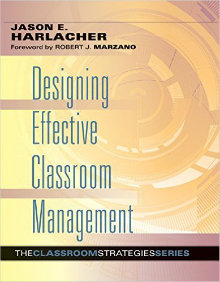Designing Effective Classroom Management
Designing Effective Classroom Management
By James E. Harlacher
(Marzano Research, 2015 – Learn more)

Robert J. Marzano introduces Jason E. Harlacher’s guide, noting his concisely created proactive system for positively managing students is based on decades of educational research.
Effective classroom control is foundational to student success and improving a learning environment. Harlacher presents useful strategies (based on strong evidence) for instructors to directly teach behavioral expectations, effectively preventing some inappropriate behaviors.

If a child doesn’t know how to read, we teach.
If a child doesn’t know how to swim, we teach.
If a child doesn’t know how to multiply, we teach….
If a child doesn’t know how to behave, we…punish?
Quoting John Herner above (p.4), Harlacher highlights misbehavior as a teaching opportunity. It opens the door to reteach, instructing the student to correctly perform the behavior he knows the 2nd time. Montessori pointed this out, too: practice makes progress, especially during the student’s “free time.”
Harlacher parallels teaching behavior with teaching content, recommending a backward design: picture the desired behavior, then potential problems, before formulating preventative rules.
Respect and integrity are integrated into lessons about expected behavior: define it; give a rationale and examples; practice and plan prompts; monitor and follow up. One of my school-made sayings is, “You pay in MAY for what you allow today.”
Helpful resources in each chapter
To facilitate implementation, tables and charts, matrixes and checklists, and lesson plan templates accompany each chapter. I especially like the behavior-specific praise, noting the students who choose a desired behavior. With praise given every two minutes, students may significantly increase their on-task behavior.
Another recommendation is to connect tangible rewards to natural consequences and social praise. Harlacher gives practical suggestions for managing rewards – short and long-term, individual and group, intermittent and independent. When a teacher creates a game that centers around expected behavior, it serves as a reminder to practice praising positive behaviors, too.
Engaging students in academic content is another key to reducing problem behaviors. Requiring students to respond frequently, in various ways, can keep them on their toes. Harlacher illustrates effective and ineffective ways to correct students so they are not distracted from practicing skills.
When misbehavior happens
Managing misbehavior is a chapter I will refer to frequently, as I often get stuck in a rut by how I react. Harlacher triangulates three levels of misbehavior, with differing strategies for each, from precorrection to error correction to extinction through overcorrection and apology letters. His final chapter describes individual behavior plans, with suggestions for personally designed interventions.
Returning to his initial proactive approach of identifying antecedents leading to behaviors leading to consequences, the author gives everyday examples of manipulating a behavior causing it to be less appealing as well as inefficient.
Acknowledging that all misbehaviors are not preventable, he lists seven steps of an escalation cycle, juxtaposing appropriate teacher responses. The desired goal is to encourage students to use the strategies taught and practiced to build their own management skills over time.
Glenda Moyer has served in an English-immersion school in Bogota, Colombia for two decades. After teaching lower elementary student for 15 years, she “graduated” to literacy coach six years ago. Earning her TESOL certificate and teaching with the SIOP model has increased to her sensitivity to ELLs. Her favorite task now is encouraging and supporting younger teachers.



































